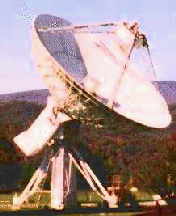 Station Software Guide
Station Software Guide
The Orbiting VLBI Tracking Station at
NRAO Green Bank
West Virginia, supports the Japanese HALCA/VSOP satellite
as a part of the NASA/JPL Deep Space Network.
The station also will support the Russian Radioastron mission.
The tracking station runs semi-autonimously, requiring
the operators to only periodically initiate a command sequence,
mount/dismount VLBI tapes, and check system status.
Below, the inputs and outputs to the tracking station
control computer are described, and the software methodology
used for controlling the station outlined. In order to understand
the software guide, a few
terms are defined and
and software design principles are given:
Principles
- The realtime system should be as simple as possible.
- Realtime command language should be simple, with no
conditional syntax. (Conditional cases are handled by programs,
not command files.)
- All inputs to realtime system are preprocessed by
offline programms, to allow changes in external specifications.
- Realtime logs should be in kept in an internal format;
output files should be generated based on log data and
phase residual measurements
- The station should be as independent as possible of external computers
and the site ethernet during tracking; All inputs/outputs to
realtime system are on internal hard drive during tracking.
- Re-use of VLBA code (written in C). In particular
use of VLBA operator interface.
- System development done in unix workstation environment.
Methodology and Notes
The OVLBI software was developed based on the VLBA software system.
In order to keep track of changes unique to OVLBI a
methode of tracking the different
software revisions was implimented using the
SCCS system.
Interfaces
The input pre-processing, realtime tasks and output post processing
are described in the following sections. The two
station inputs from external sources are first processed
"offline" before use in the "real-time" system.
There are 5 output file specifications,
which are produced from the real-time logs and the
phase residuals measured during the tracking pass.
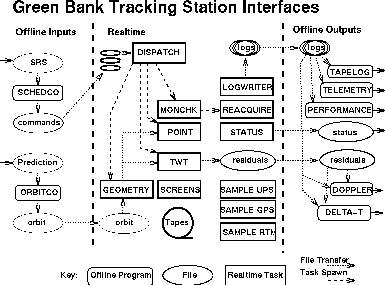 There are only two inputs to the station; a
Space Radio-Telescope Schedule (SRS)
file, and a satellite orbit prediction.
The two station inputs are described by specifications
between the tracking station and the other mission elements.
There are only two inputs to the station; a
Space Radio-Telescope Schedule (SRS)
file, and a satellite orbit prediction.
The two station inputs are described by specifications
between the tracking station and the other mission elements.
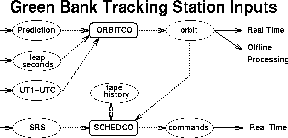 During tracking passes, all stations functions are coordinated
by a single MVME147 single board computer.
Many station tasks controlling the real-time operations
run simultaenously.
At the beginning of tracking passes, all needed command files
and satellite orbits are copied to the real-time hard drive.
After the initial files are copied, then no offline files
are needed during the tracking passes.
During the tracking pass, the real-time logs are copied offline
every 15 minutes. If the site ethernet or some other offline
component has failed, there should be no loss of real-time
log data. Also during the tracking passes, the "status" file
is regularly updated. The status file contains an ascii
description of the station activites.
After the tracking pass, all the phase residual data are copied
are copied offline. The final output files are created
offline after the tracking pass has ended.
During tracking passes, all stations functions are coordinated
by a single MVME147 single board computer.
Many station tasks controlling the real-time operations
run simultaenously.
At the beginning of tracking passes, all needed command files
and satellite orbits are copied to the real-time hard drive.
After the initial files are copied, then no offline files
are needed during the tracking passes.
During the tracking pass, the real-time logs are copied offline
every 15 minutes. If the site ethernet or some other offline
component has failed, there should be no loss of real-time
log data. Also during the tracking passes, the "status" file
is regularly updated. The status file contains an ascii
description of the station activites.
After the tracking pass, all the phase residual data are copied
are copied offline. The final output files are created
offline after the tracking pass has ended.
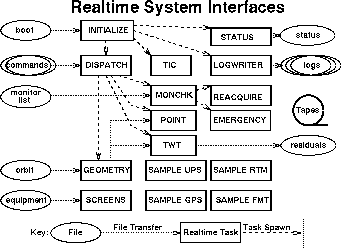 The station outputs are created from the realtime logs and
from the phase residuals measured during the pass.
During the tracking passes, the HALCA telemetry data are extracted
every 15 minutes and placed in an anonymous ftp area for
"near-real-time" access to the state of the satellite.
All other offline data files are produced after the tracking pass
is finished. The first step in creating the output data files
is merging the 15 minute length logs into a single log file for
the entire days log entries. Next the tracking pass for the day
are summarized. The station operators generate the other output
data files based on the tracking pass summary.
The station outputs are created from the realtime logs and
from the phase residuals measured during the pass.
During the tracking passes, the HALCA telemetry data are extracted
every 15 minutes and placed in an anonymous ftp area for
"near-real-time" access to the state of the satellite.
All other offline data files are produced after the tracking pass
is finished. The first step in creating the output data files
is merging the 15 minute length logs into a single log file for
the entire days log entries. Next the tracking pass for the day
are summarized. The station operators generate the other output
data files based on the tracking pass summary.
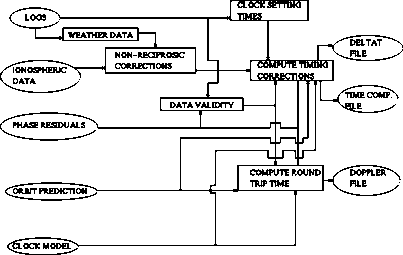 Both of the station inputs are automatically retrieved from the
source by offline system "cron" jobs, which periodically
search for new station inputs.
If new inputs are found, the cron jobs run to retrieve and process
the inputs.
The station logs are automatically merged each day to produce
a single log for the days events.
The summary of tracking pass events is also generated by a cron
job and e-mailed to the tracking station staff.
The software methodology for realtime and offline have some
similarities and differences.
The station software is developed in a unix workstation envirionment.
Almost all station code is written in C, and is extensively commented.
Changes to all code and many documents are kept track of
using the SCCS revision control system.
Both of the station inputs are automatically retrieved from the
source by offline system "cron" jobs, which periodically
search for new station inputs.
If new inputs are found, the cron jobs run to retrieve and process
the inputs.
The station logs are automatically merged each day to produce
a single log for the days events.
The summary of tracking pass events is also generated by a cron
job and e-mailed to the tracking station staff.
The software methodology for realtime and offline have some
similarities and differences.
The station software is developed in a unix workstation envirionment.
Almost all station code is written in C, and is extensively commented.
Changes to all code and many documents are kept track of
using the SCCS revision control system.
Software Documentation
Online documents describing the input specifications,
designs, and user mannuals are kept with the Input, Realtime and
Output descriptions.
The primary interace documents are kept at
ISAS .
However, some clarifications to the
specifications are kept in local documents.
The use of diagnostic software is an important part of
station maintainence. The regular use of plotting functions
is needed to assure good quality link to the satellite is maintained.
Return
to the station home page.
The National Radio Astronomy Observatory
(NRAO)
is a facillity of the
National Science Foundation
operated under cooperative agreement by
Associated Universities, Inc.
glangsto@nrao.edu tminter@nrao.edu
Last update: 97 July 1
 Station Software Guide
Station Software Guide Station Software Guide
Station Software Guide


